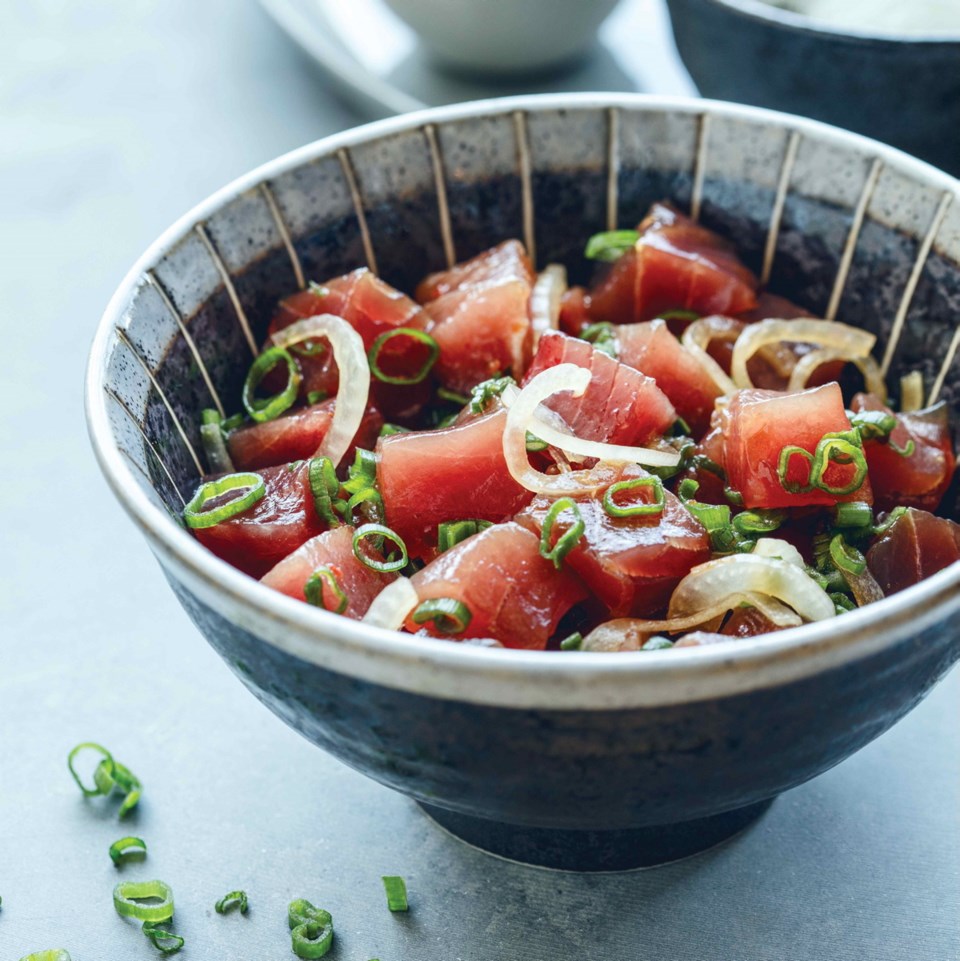I asked Honolulu-based food writer Martha Cheng about HawaiiŌĆÖs favourite foods and where she would place poke on a scale of one to 10.
ŌĆ£10,ŌĆØ she said. ŌĆ£We eat it anytime and anywhere.ŌĆØ
Cheng said in Hawaii these days, the beloved raw-fish salad ŌĆö pronounced ŌĆ£POH-kayŌĆØ ŌĆö is easy to find, as itŌĆÖs sold at all kinds of places, from restaurants to supermarkets, food trucks and even gas stations. Pieces of fish glisten in seasonings that range from sweet to salty, nutty to crunchy.
In her recently published compact book The Poke Cookbook (Clarkson Potter, $22.99), Cheng does a good job of explaining why poke is so popular in Hawaii and is now also being dished up in parts of North America, including Victoria.
Cheng writes that poke evolved from a raw-fish dish called iŌĆÖa maka that native Hawaiians made long before Captain Cook set foot on the islands in the 18th century.
ItŌĆÖs made by chopping up reef fish, bones and all, and mixing it with other local ingredients, such as sun-dried sea salt, limu (seaweed) and inamona, roasted and crushed kukui nuts, also called candlenuts.
Despite this style of dish having a long history in Hawaii, Cheng says it did not become widely popular until the 1970s, when when it became known as poke. Over time, its ingredients were adjusted to reflect HawaiiŌĆÖs multicultural influences, particularly Japanese and American ones.
Cheng says her bookŌĆÖs shoyu ŌĆÖahi recipe, which she says is now considered the classic poke, showcases that evolution.
Ahi tuna replaces the bony reef fish, sesame oil steps in for inamona, crunchy raw yellow onion replaces the limu, and shoyu (soy sauce) replaces the salt.
ŌĆ£Fresh fish, with just the right amount of salt and crunchiness and richness, with just a slight hint of sweetness,ŌĆØ is how Cheng describes that poke when well made.
Poke means ŌĆ£to slice.ŌĆØ ThatŌĆÖs a clear indication that, beyond proper seasoning, how you cut fish for poke is also highly important.
For example, you must slice fish fillets into cubes against the grain, distinct lines that run through the flesh. If you slice the fish in the same direction as those lines, youŌĆÖll have to bite through those fibres.
Cheng writes about that in more depth in a section of her book called ŌĆ£Getting ready to poke.ŌĆØ There, she also discusses such things as how to purchase seafood for poke, how to store it and what pantry items to keep hand to make poke.
Cheng says that in Hawaii, the base mix of flavours used in shoyu ŌĆÖahi is now used with all sorts of seafood and even non-seafood.
Other ingredients, such as miso, bonito flakes, mirin and ginger, are added or used in place of those found in shoyu ŌĆÖahi, depending on the style of poke being made, of which there are now many.
In fact, The Poke Cookbook features 45 recipes for traditional types of poke, modern styles and even vegetable poke. Some of her poke recipes include kimchi salmon, tofu and sea asparagus, Sichuan shrimp and tobiko, Thai mussels, beet and macadamia, and sweet potato and cilantro.
The book also has a chapter on making poke bowls, more complete meals where the poke is served on such things as flavoured noodles or rice.
The Poke Cookbook, which is available in bookstores and online, is ideal for those looking to replicate what would be served in Hawaii, as well as those seeking creative takes on poke, Cheng said.
ŌĆ£ItŌĆÖs also a great way to prepare any kind of fish that can be eaten raw. I imagine Victoria has some fabulous seafood that Hawaii doesnŌĆÖt have that also lends itself well to poke.ŌĆØ
Note: If youŌĆÖll be visiting Honolulu and want to try poke at an eatery there, establishments Cheng recommended included Ono Seafood, Ahi Assassins and Maguro Brothers.
╠²
Shoyu ŌĆÖAhi
This recipe is reprinted from Martha ChengŌĆÖs The Poke Cookbook (Clarkson Potter, $22.99). Cheng writes that this is the classic poke.
At poke counters in Hawaii, youŌĆÖll find this base mix used for all sorts of seafood, such as salmon, kajiki (blue marlin) or abalone, and even non-seafood items such as tomatoes or edamame.
╠²
1 lb sushi-grade tuna, cut into 3/4-inch pieces (see Note)
1/2 cup thinly sliced yellow onion
1/2 cup thinly sliced scallions (green parts only)
2 Tbsp soy sauce, plus more to taste
1 tsp toasted sesame oil
1/2 tsp sambal oelek (spicy Asian-style chili paste)
In a medium bowl, combine all the ingredients. Fold gently until evenly distributed. Taste, and adjust with more soy sauce as desired.
Serve immediately, or cover tightly and refrigerate for up to a day. If you let the poke marinate, taste it again right before serving; you may want to add another splash of soy sauce. Serves 4.
╠²
Note from Eric Akis
In Victoria, pieces of frozen, sushi-grade fish, such as salmon and albacore tuna, are sold at Japanese food stores, some seafood stores and some supermarkets.
Sushi-grade fish are frozen below -20 C for seven days, or below -35 C for 15 hours, to destroy parasites that might be present.
The safest way to thaw it is in the refrigerator, which will take several hours or overnight.
You can also find fresh, hand-line-caught ahi tuna for sale at some supermarkets in Victoria, such as Thrifty Foods.
According to government sources, itŌĆÖs not prone to having parasites, so if itŌĆÖs very fresh, sea-like in aroma and firm, it will be a great choice for this poke recipe.
Eric Akis is the author of eight cookbooks. His columns appear in the Life section Wednesday and Sunday.



